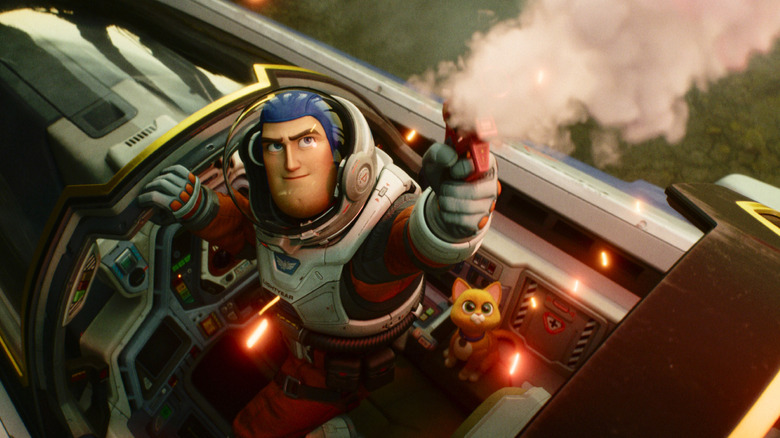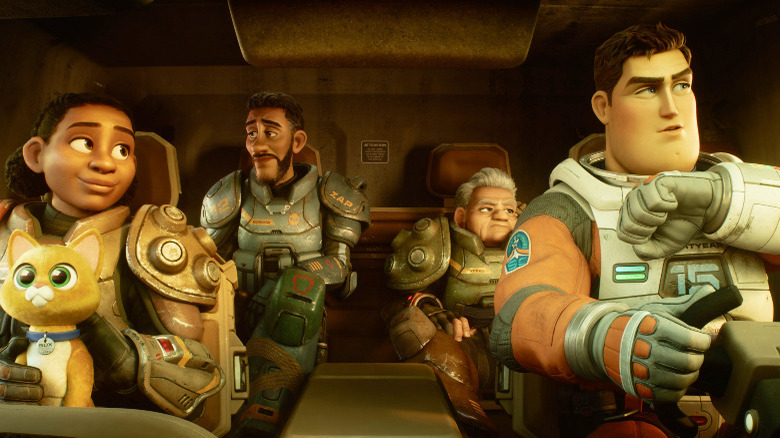Lightyear Means More To Toy Story Canon Than Even The Writers Realized
"Maybe it's time you question the nature of your own reality."
That's a line from the upcoming "Westworld" season 4, but it's also advice that characters in certain Pixar films can benefit from taking. Indeed, if you've ever watched one of the studio's "Cars" movies, you may have found yourself focusing less on Mater's hijinks and more on wondering what happened to all the humans in this world (or how cars are born). You wouldn't be the first to fall down that rabbit hole, either. Writer Jon Negroni (in)famously came up with what he called "The Grand Unifying Theory of Pixar Movies," postulating that all Pixar films take place in the same timeline. To quote one of the great philosophical minds of our time, "Whoa."
"Lightyear," the latest feature film from the animation powerhouse, only further muddies the water with its meta premise. As is explained in the opening minutes, the movie itself exists in the "Toy Story" universe and was released in 1995, in turn giving rise to the Buzz Lightyear toyline. Was it also banned in select countries because of its same-sex kiss like in our reality, or is the "Toy Story" world a much more progressive place? Were family-friendly 1990s sci-fi films in that universe radically different than ours, or was "Lightyear" a nostalgic throwback? Is the actor who plays Buzz in "Lightyear" also named Chris Evans, or do they merely sound exactly alike?
Lest you go in expecting "Lightyear" to be the Pixar equivalent of the 2002 Nicolas Cage mind-trip "Adaptation," it should be noted that the film doesn't address most (or, rather, any) of these queries. For that matter, the movie has implications for the "Toy Story" canon that even co-writer and director Angus MacLane and producer Galyn Susman hadn't realized.
A Taika Waititi action figure, you say?
Besides, obviously, Buzz himself, "Lightyear" features space-faring heroes like Buzz's friend and commanding officer at Star Command, Alisha Hawthorne (Uzo Aduba). There's also Alisha's granddaughter Izzy (Keke Palmer), Buzz's robot cat companion Sox (Peter Sohn), and such newbie space rangers as Mo Morrison (Taika Waititi).
When The Mary Sue asked Angus MacLane and Galyn Susman if that meant there was a toy modeled after Mo in the "Toy Story" universe, the outlet described them as being visibly taken aback. "Are you saying a Taika toy styled like the Buzz Lightyear toy from 'Toy Story?'" MacLane asked. After TMS said yes, he admitted:
"I haven't thought about that. But yes, that makes sense. It would be neat to see what [Mo] would look like in the 'Toy Story' Buzz stylization. It's a neat idea. Because just the way I thought about was: There's the movie in the 'Toy Story' universe and then there's maybe some sequels or whatever but then that becomes an off-shoot TV show that has slightly more 2D designs and that's what inspired the 'Toy Story' toy just because they had different stylization levels. So, yeah, I guess you could imagine that. That's a great idea."
To be fair, there was never really any need for MacLane and Susman to even consider a question like that until now. For better or for worse, "Lightyear" doesn't explore its meta premise beyond its opening. It is, for all intents and purposes, an original pastiche that's mainly interested in using a popular Pixar character as an excuse for paying homage to pulpy space adventure movies of the past, rather than trying to make heads or tails of the "Toy Story" canon. That's where we come in.
"Lightyear" opens in theaters on June 17, 2022.

